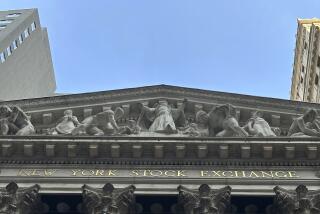Stock Market Barometers
- Share via
Fundamental and technical indicators of the market’s health
Key indexes vs. their 200-day moving averages:
A stock index’s 200-day moving average indicates the basic trend, up or down. It is generally bullish if the index stays above the average.
S&P; 500 (blue-chip stocks): Friday: 1,120.67
200-day moving average: 1,045.22
*
Russell 2,000 index (smaller stocks): Friday: 419.75
200-day moving average: 450.94
*
Price-to-earnings ratio of Standard & Poor’s 500: 24.68*
Based on operating earnings per share, 12 months ended March 31;
average since 1923: 13.5
Dividend yield of the Standard & Poor’s 500: 1.44%
Average dividend yield of blue-chip stocks; avg. since 1923: 4.5%
Weekly new highs vs. new lows on the NYSE: 92/626
Data for the week ended Friday. More highs indicate a bullish trend.
Investment newsletter sentiment:
Stocks’ near-term trend as predicted by 135 independent investment newsletters, weekly survey by Investors Intelligence. The data are often viewed as a contrarian indicator: A rising percentage of bulls can signal a topping market.
July 24
Bullish: 54.3%
Bearish: 23.3%
Correction: 22.4%
*
Friday
Bullish: 52.5%
Bearish: 26.3%
Correction: 21.2%
*
Put-call ratio: 0.45
The ratio of stock put options to call options traded last week on the Chicago Board Options Exchange. Ironically, a low put-call ratio--under 0.40--can be construed as bearish because it indicates a high level of optimism, leaving a lot of room for disappointment.
* Now calculated based on operating earnings, which exclude one-time charges--so P/E is lower than if actual earnings were used.
Source: A.G. Edwards & Sons. More information can be found at
https://www.agedwards.com on the World Wide Web.Stock Market Barometers
More to Read
Inside the business of entertainment
The Wide Shot brings you news, analysis and insights on everything from streaming wars to production — and what it all means for the future.
You may occasionally receive promotional content from the Los Angeles Times.










